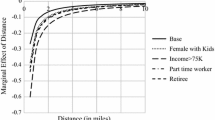Abstract
In modeling time of day choice, constructing choice alternatives in the case of joint tours requires the temporal synchronization of travel of all members of the travel party. This study describes how the time constraints of multiple persons can be effectively accommodated into determining the choice set and, subsequently, the choice of timing for joint social/recreational tours. Many previous studies on time-of-day choice modeling have been dominated by dividing the continuous time variable into discrete time intervals. Although the continuous representation of time in the method was proposed, their relative complexity in the estimation over the discrete choice methods is a drawback from practical perspectives. In this study, an alternate two-step approach is proposed. The first model predicts the time-window chosen for pursuing the joint discretionary tour, and the second model locates the tour within the chosen time window by determining the start- and end-hours of the tour simultaneously on a continuous scale. A MNL model within the discrete contexture is also estimated as for the predictive assessment comparison. A wide set of explanatory variables were included in the model estimations. The models developed are used to assess predictive abilities using validation samples. Overall, the fractional-split model is shown to be effective from the standpoint of predictive accuracy over the reference model based on the discrete time representations.
Similar content being viewed by others
References
Bhat, C. R. (1998a). “Analysis of travel mode and departure-time choice for urban shopping trips.” Transportation Research B, Vol. 32, No. 6, pp. 361–371, DOI: 10.1016/S0191-2615(98)00004-6.
Bhat, C. R. (1998b). “Accommodating flexible substitution patterns in multi-dimensional choice modeling: Formulation and application to travel mode and departure time choice.” Transportation Research B, Vol. 32, No. 7, pp. 455–466, DOI: 10.1016/S0191-2615(98)00011-3.
Bhat, C. R. and Steed, J. L. (2002). “A continuous-time model of departure time choice for urban shopping trips.” Transportation Research Part B, Vol. 36, pp. 207–224, DOI: 10.1016/S0191-2615(00)00047-3.
Bowman, J. L. and Bradley, M. (2006). SACSIM/05 Activity-Based Travel Forecasting Model for SACOG Freaturing DaySIM-the Person Day Activity and Travel Simulator, Technical Memo Number 7, Time of Day/Activity Scheduling Models, Draft 2.
Davidson, W., Vovsha, P., Freedman, J., and Donnelly, R. (2010). CTRAMP Family of Activity-Based Models, Australasian Transportation Research Forum 2010 Proceeding.
Ettema, D. and Timmermans, H. (2003). “Modeling departure time choice in the context of activity scheduling behavior.” Transportation Research Record, 1831. No. 03-2425, pp. 39–46, DOI: 10.3141/1831-05.
Gadda, S., Kockelman, K. M., and Damien, P. (2009). “Continuous Departure Time Models: A bayesian approach.” Transportation Research Record, 2132, pp. 13–24, DOI: 10.3141/2132-02.
García-Garcés, P. and Ruiz, T. (2013). “Simultaneous analysis of global decisions in activity travel scheduling process.” Transportation Research Record, Vol. 2382, pp. 121–131, DOI: 10.3141/2382-14.
Guo, J. Y., Srinivasan, S., Eluru, N., Pinjari, A., Copperman, R., and Bhat, C. (2005). Activity based travel-demand analysis for metropolitan areas in texas: CEMSELTS model estimations and prediction procedures, 4874 Zone System CEMDAP Model Estimations and Procedures, and the SPG Software Details, Report 4080-7, prepared for the Texas Department of Transportation.
Hess, S., Polak, J. W., and Bierlaire, M. (2005). Functional approximation to alternative-specific constants in time-period choice modeling, CTS Working paper, Centre for Transport Studies, Imperial College London.
Komma, A. (2008). Continuous departure-time choice models for home-to-work commute, University of Florida, Master Thesis.
Lim, K. K. (2015). “Modeling intra-household interactions in the generation of social-recreational tours.” KSCE Journal of Civil Engineering, Vol. 19, No. 6, pp. 1870–1881, DOI: 10.1007/s12205-014-0156-4.
Okola, A. (2003). “Departure time choice for recreational activities by elderly Nonworkers.” Transportation Research Record, 1848. pp. 86–93, DOI: 10.3141/1848-12.
PB Americas, Inc. (2009). Activity-based travel model specifications: Coordinated Travel-Regional Activity Based Modeling Platform (CT-RAMP) for the Atlanta Region.” Atlanta Regional Commission.
Pinjari, A., Eluru, N., Srinivasan, S., Guo, J. Y., Copperman, R. B., Sener, I. N., and Bhat, C. R. (2008). CEMDAP: Modeling and Microsimulation Frameworks, Software Development, and Verification, TRB 87th Annual Meeting CD-ROM, Washington, D.C..
Saleh, W. and Farrell, S. (2005). “Implications of congestion charging for departure time choice: work and non-work schedule flexibility.” Transportation Research Part A, Vol. 39, pp. 773–791, DOI: 10.1016/j.tra.2005.02.016.
Sivakumar, A. and Bhat, C. (2002). “A fractional split distribution model for statewide commodity flow analysis.” Transportation Research Record, Vol. 1790, pp. 80–88, DOI: 10.3141/1790-10.
Srinivasan, S. (2007). Fractional-split models of the time-use patterns of elderly americans, For presentation at the International Association for Time-Use Research Conference, October 1719, Washington D.C., U.S.A.
Steed, J. and Bhat, C. (2000). “On modeling departure time choice for home-based social/recreational and shopping trips.” Transportation Research Record, Vol. 1706, pp. 152159, DOI: 10.3141/1706-18.
Vovsha P. and Bradley, M. (2004). “Hybrid discrete choice departuretime and duration model for scheduling travel tours.” Transportation Research Record, Vol. 1894, pp. 46–56, DOI: 10.3141/1894-06.
Ye, X. and Pendyala, R. M. (2005). “A model of daily time use allocation using fractional logit methodology.” 16th International Symposium on Transportation and Traffic Theory, pp. 507–524.
Author information
Authors and Affiliations
Corresponding author
Rights and permissions
About this article
Cite this article
Lim, KK., Srinivasan, S. Modeling the choice of time-of-day for joint social-recreational activities. KSCE J Civ Eng 21, 2859–2867 (2017). https://doi.org/10.1007/s12205-017-0807-3
Received:
Revised:
Accepted:
Published:
Issue Date:
DOI: https://doi.org/10.1007/s12205-017-0807-3




